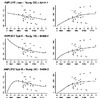| dc.contributor.author | Keith, David | |
| dc.date.accessioned | 2014-08-21T11:59:52Z | |
| dc.date.available | 2014-08-21T11:59:52Z | |
| dc.date.issued | 2014-08-21 | |
| dc.identifier.uri | http://hdl.handle.net/10222/53966 | |
| dc.description.abstract | In the first part of this thesis I attempt to address some of the concerns regarding the
stock-recruitment relationship that have been voiced over the last 50 years. In chapter
2 I revisit the shape of the stock-recruitment relationship at low abundance. I show
that at these low abundances an increase in productivity is not ubiquitous. In many
populations the dynamics are essentially density independent after the populations
decline below 40% of maximum historic SSB, and in some species the productivity
actually starts to decline below this threshold. Given the weakening of compensation
in many populations, in chapter 3 I examine how per capita harvest mortality
changes with abundance. The results show that in the majority of populations, per
capita mortality continues to increase with declines in abundance. In Chapter 4, I
attempt to address concerns that have been raised about the effect of age structure
on recruitment. Here, I break down the relationship to determine whether there is
an effect of first time (virgin) or repeat spawners in terms of average size, and the
relative abundance of large and small fish. The results suggest that these age-specific
components of the spawning stock contribute differentially to recruitment across a
wide range of species and populations. In Chapters 5 and 6 I change the focus and
use a technique widely used in terrestrial ecology to estimate both the risk of collapse
and the probability of persistence for numerous populations of Atlantic cod
(Gadus morhua) and Atlantic herring (Clupea harengus). In chapter 5 the models
indicate that periods of unusually elevated recruitment are vital to the persistence
of all the populations analyzed. In Chapter 6, I look specifically at the potential
impact that different management actions and environmental variability may have
on population recovery for an endangered Atlantic cod population in the Gulf of St.
Lawrence. Throughout this thesis, I attempt to address problems in fisheries science
from a more ecological perspective than that traditionally used in fisheries science.
More collaboration between ecologist scientists and fisheries scientist will only help
to improve our understanding of population dynamics in both marine and terrestrial
ecosystems. | en_US |
| dc.language.iso | en | en_US |
| dc.subject | Fisheries | en_US |
| dc.subject | Biology | en_US |
| dc.subject | Ecology | en_US |
| dc.subject | Population viability analysis | en_US |
| dc.subject | Allee effect | en_US |
| dc.subject | recovery | en_US |
| dc.subject | harvesting | en_US |
| dc.title | FORECASTING FUTURES - THE EFFECT OF AGE, ABUNDANCE, AND HARVESTING ON THE LONG-TERM SUSTAINABILITY OF MARINE FISHES | en_US |
| dc.date.defence | 2014-08-11 | |
| dc.contributor.department | Department of Biology | en_US |
| dc.contributor.degree | Doctor of Philosophy | en_US |
| dc.contributor.external-examiner | Dr. Andrew Cooper | en_US |
| dc.contributor.graduate-coordinator | Dr. Hal Whitehead | en_US |
| dc.contributor.thesis-reader | Dr. Nancy Shackell | en_US |
| dc.contributor.thesis-reader | Dr. Hal Whitehead | en_US |
| dc.contributor.thesis-supervisor | Dr. Jeff Hutchings | en_US |
| dc.contributor.ethics-approval | Not Applicable | en_US |
| dc.contributor.manuscripts | Yes | en_US |
| dc.contributor.copyright-release | Yes | en_US |




